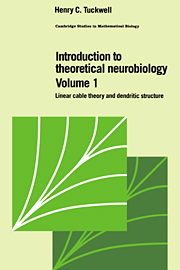Book contents
- Frontmatter
- Contents
- Preface
- 1 Introductory neuroanatomy and neurophysiology: the properties of motoneurons
- 2 The classical theory of membrane potentials
- 3 The Lapicque model of the nerve cell
- 4 Linear cable theory for nerve cylinders and dendritic trees: steady-state solutions
- 5 Time-dependent cable theory for nerve cylinders and dendritic trees
- 6 Rail's model neuron
- References
- Index
3 - The Lapicque model of the nerve cell
Published online by Cambridge University Press: 29 December 2009
- Frontmatter
- Contents
- Preface
- 1 Introductory neuroanatomy and neurophysiology: the properties of motoneurons
- 2 The classical theory of membrane potentials
- 3 The Lapicque model of the nerve cell
- 4 Linear cable theory for nerve cylinders and dendritic trees: steady-state solutions
- 5 Time-dependent cable theory for nerve cylinders and dendritic trees
- 6 Rail's model neuron
- References
- Index
Summary
Introduction
One fundamental principle in neural modeling is that one should use the simplest model that is capable of predicting the experimental phenomena of interest. A nerve-cell model must necessarily contain parameters that admit of physical interpretation and measurement, so that it is capable of predicting the different quantitative behaviors of different cells.
The model we will consider in this chapter is very simple and leads only to first-order linear differential equations for the voltage. However, when we employ the model in many situations of neurophysiological interest, we find that the mathematical analysis becomes quite difficult, due mainly to the nonlinearities introduced by the imposition of a firing threshold. This will become even more apparent in Chapter 9, where we consider stochastic versions of this model.
The model will be called the Lapicque model after the neurophysiologist who first employed it in the calculation of firing times (Lapicque 1907). Other names for this model, which have recently appeared in the literature are the leaky integrator or the forgetful integrate and fire model.
According to Eccles (1957) the resting motoneuron membrane can be represented by the circuit shown in Figure 3.1A. A battery with a potential difference equal to that of the resting membrane potential maintains that potential across the membrane circuit elements consisting of a resistor and capacitor in parallel. We call this a lumped model or a point model to indicate that the whole cell (with attention focused on the soma and dendrites) is lumped together into one representative circuit.
- Type
- Chapter
- Information
- Introduction to Theoretical Neurobiology , pp. 85 - 123Publisher: Cambridge University PressPrint publication year: 1988
- 2
- Cited by



